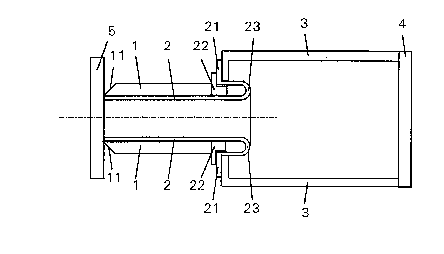Some of the information on this Web page has been provided by external sources. The Government of Canada is not responsible for the accuracy, reliability or currency of the information supplied by external sources. Users wishing to rely upon this information should consult directly with the source of the information. Content provided by external sources is not subject to official languages, privacy and accessibility requirements.
Any discrepancies in the text and image of the Claims and Abstract are due to differing posting times. Text of the Claims and Abstract are posted:
| (12) Patent Application: | (11) CA 2235793 |
|---|---|
| (54) English Title: | ENERGY-ABSORBING DEVICE |
| (54) French Title: | DISPOSITIF A ABSORPTION D'ENERGIE |
| Status: | Deemed Abandoned and Beyond the Period of Reinstatement - Pending Response to Notice of Disregarded Communication |
| (51) International Patent Classification (IPC): |
|
|---|---|
| (72) Inventors : |
|
| (73) Owners : |
|
| (71) Applicants : |
|
| (74) Agent: | SMART & BIGGAR LP |
| (74) Associate agent: | |
| (45) Issued: | |
| (22) Filed Date: | 1998-04-24 |
| (41) Open to Public Inspection: | 1998-10-25 |
| Examination requested: | 2003-01-09 |
| Availability of licence: | N/A |
| Dedicated to the Public: | N/A |
| (25) Language of filing: | English |
| Patent Cooperation Treaty (PCT): | No |
|---|
| (30) Application Priority Data: | ||||||
|---|---|---|---|---|---|---|
|
An energy-absorbing device, particularly for rolling
stock to provide protection therefor when potentially
damaging impact occurs, includes first and second tubular
elements which are fitted into one another and which are of
unlike material.
Dispositif à absorption d'énergie visant à offrir une protection contre les impacts potentiellement dommageables pour le matériel roulant, en particulier. Il est constitué d'un premier et d'un second éléments tubulaires d'un matériau dissemblable ajustés l'un dans l'autre.
Note: Claims are shown in the official language in which they were submitted.
Note: Descriptions are shown in the official language in which they were submitted.

2024-08-01:As part of the Next Generation Patents (NGP) transition, the Canadian Patents Database (CPD) now contains a more detailed Event History, which replicates the Event Log of our new back-office solution.
Please note that "Inactive:" events refers to events no longer in use in our new back-office solution.
For a clearer understanding of the status of the application/patent presented on this page, the site Disclaimer , as well as the definitions for Patent , Event History , Maintenance Fee and Payment History should be consulted.
| Description | Date |
|---|---|
| Application Not Reinstated by Deadline | 2005-04-25 |
| Time Limit for Reversal Expired | 2005-04-25 |
| Deemed Abandoned - Failure to Respond to Maintenance Fee Notice | 2004-04-26 |
| Letter Sent | 2003-02-11 |
| Amendment Received - Voluntary Amendment | 2003-01-29 |
| All Requirements for Examination Determined Compliant | 2003-01-09 |
| Request for Examination Requirements Determined Compliant | 2003-01-09 |
| Request for Examination Received | 2003-01-09 |
| Letter Sent | 2001-05-23 |
| Inactive: Multiple transfers | 2001-04-19 |
| Letter Sent | 2000-10-06 |
| Inactive: Multiple transfers | 2000-09-08 |
| Inactive: Correspondence - Transfer | 1999-01-14 |
| Inactive: Courtesy letter - Evidence | 1998-12-22 |
| Inactive: Single transfer | 1998-11-04 |
| Application Published (Open to Public Inspection) | 1998-10-25 |
| Inactive: IPC assigned | 1998-08-03 |
| Classification Modified | 1998-08-03 |
| Inactive: IPC assigned | 1998-08-03 |
| Inactive: First IPC assigned | 1998-08-03 |
| Inactive: IPC assigned | 1998-07-30 |
| Inactive: Courtesy letter - Evidence | 1998-07-14 |
| Inactive: Applicant deleted | 1998-07-08 |
| Inactive: Filing certificate - No RFE (English) | 1998-07-08 |
| Application Received - Regular National | 1998-07-06 |
| Abandonment Date | Reason | Reinstatement Date |
|---|---|---|
| 2004-04-26 |
The last payment was received on 2003-04-16
Note : If the full payment has not been received on or before the date indicated, a further fee may be required which may be one of the following
Patent fees are adjusted on the 1st of January every year. The amounts above are the current amounts if received by December 31 of the current year.
Please refer to the CIPO
Patent Fees
web page to see all current fee amounts.
| Fee Type | Anniversary Year | Due Date | Paid Date |
|---|---|---|---|
| Application fee - standard | 1998-04-24 | ||
| Registration of a document | 1998-11-04 | ||
| MF (application, 2nd anniv.) - standard | 02 | 2000-04-25 | 2000-04-13 |
| Registration of a document | 2000-09-08 | ||
| MF (application, 3rd anniv.) - standard | 03 | 2001-04-24 | 2001-03-19 |
| Registration of a document | 2001-04-19 | ||
| MF (application, 4th anniv.) - standard | 04 | 2002-04-24 | 2002-03-18 |
| Request for examination - standard | 2003-01-09 | ||
| MF (application, 5th anniv.) - standard | 05 | 2003-04-24 | 2003-04-16 |
Note: Records showing the ownership history in alphabetical order.
| Current Owners on Record |
|---|
| ABB DAIMLER-BENZ TRANSPORTATION (TECHNOLOGY) GMBH |
| DAIMLERCHRYSLER RAIL SYSTEMS GMBH |
| Past Owners on Record |
|---|
| FRANZ JOSEF BAYER |
| FRIEDRICH WERNER |
| MANFRED RIEGLER |
| MATTHIAS NORH |